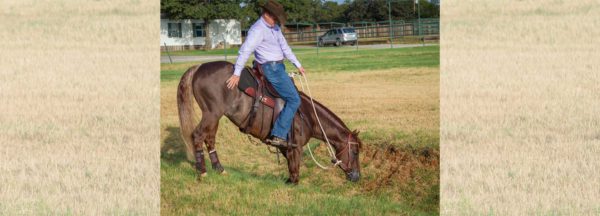Training Tip: Stopping a Horse From Rushing Over Trail Obstacles

Question: I have been training my wife’s new horse for a while now. He is through Intermediate, and has lots of long trail rides under his belt. He has one bad habit, though, which scares my wife: When we come to a step down off a rock, say one foot or so, he will leap off it, like a crazy skydiver, rather than just stepping carefully down. Our trails are narrow and confined, how can I break this habit? – fracchiolla
Clinton’s Answer: It’s completely normal for horses to react this way when confronted with an obstacle that requires them to either step down or step up. The secret to getting your horse to calmly negotiate this type of obstacle, or any obstacle for that matter, is to practice taking him over it over and over again. He can’t build his confidence about stepping down off an embankment if he’s never allowed to practice it. It should go without saying that in order to build his confidence, you should start with the smallest drop-off you can find. Don’t try to get him to calmly step down a 3-foot drop-off. It’s also wise to practice this in a safe situation, meaning don’t try to step him down or up a rocky ledge where he’s likely to overreact, slip and fall or do something equally as dangerous. Instead, practice on solid dirt, where you’ll have good footing to train on him.
Discourage the horse from wanting to scramble down or up a drop-off by working his feet on either end of it. I make the right thing (walking slowly) easy and the wrong thing (rushing) difficult. Ask the horse to step down the embankment. If he wants to rush, let him. Don’t try to hold him back or pull on the reins to stop him. Once all four of his feet are on the ground, immediately bend him in a circle. Most horses will have a tendency to veer off in one direction when they reach the bottom. Whichever direction your horse veers off in, turn him in the opposite direction and hustle his feet in bending circles, trot him around nearby bushes or trees. It doesn’t matter how you move the horse’s feet, just that you make him hustle with some urgency. A good rule of thumb is to bend your horse in four circles to the right and then four circles to the left.
If you have limited room, you may have to just bend the horse around in a few circles. But even if you only have room to do that, don’t let the horse just walk around dragging his feet. If he’s being lazy, use your inside leg to thump his side and put a little pressure on him to soften him and pick up his feet. Remember, you’re trying to make this the difficult part of the equation for the horse. You want him to realize that scrambling down the embankment only gets him to more work faster.
If the trail you’re riding your horse on is so narrow that you can’t bend him in a circle, then you need to find another trail to practice on or create the situation at your home. It’s not fair to your horse if you’re not providing him with the opportunity to build his confidence. Remember, if you want something bad enough, you’ll find a way. If you don’t, you’ll find an excuse.
When the horse feels soft in your hands and is walking forward in the circle, send him up the embankment. When a horse is going up an embankment, he will have to put in a little extra muscle to get up it. So you have to be reasonable about the energy he’ll need to use. Once he’s across it, immediately hustle his feet by circling objects or bending him in a circle.
Continue to repeat that process on the same embankment until the horse slows down and thinks about where he’s placing his feet. With repetition, he’ll not want to rush down or up the embankment because he knows he’s going to have to sweat and work hard there. How long it takes for the horse to come to this realization depends on the individual. If a horse is a chronic rusher, you can make an improvement in one training session, but more than likely it’ll take several sessions in a row to erase his old habits. Remember, it didn’t take him just one time to develop that longstanding bad habit.
Have a horsemanship question or looking for more training tips? Check out the No Worries Club.
